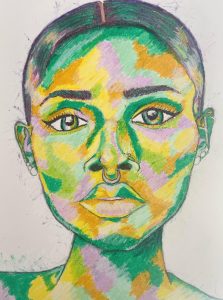Challenging Bias Through Art: YSDNDYart’s Mission for Social Change

My journey back into art began during the lockdown. Whilst on furlough, I revisited creative passions I’d set aside over a decade ago. Initially, I turned to painting as a therapeutic outlet to cope with the period’s challenges and to process the racist experiences I’d endured in the workplace.
However, my art soon evolved into something more powerful. As others began expressing genuine interest in my work, I realised the broader impact it could have—not just on myself but on the community around me. I subsequently launched YSDNDYart; an innovative art brand dedicated to using creativity as a vehicle for social change.
Leaving the corporate world and securing an art studio last year was a leap of faith, but it felt like a necessary step towards fulfilling my mission.
Over the past one and a half years, I believe YSDNDYart has developed an unmistakable style that goes beyond aesthetics, fostering a dialogue about race, identity, and equality. Through striking portraits that deliberately omit natural skin tones, my work aims to challenge societal constructs and conditioned biases, helping to dismantle long-held stereotypes.
At the core of YSDNDYart’s mission is the belief that Your Skin Does Not Define You; from which the acronym derives. My portraits remove the weight that skin colour holds in society, emphasising the fallacy of race as a construct and its accompanying socio-political and economic stratifications. This visual choice sends a powerful message: skin colour is nothing more than an evolutionary trait, yet it bears so much societal weight. By portraying my subjects in vibrant, unexpected colours, I strip away race—the first thing society tends to see—inviting viewers to focus on the individual for whom they truly are, beyond their skin colour. Whilst race is ultimately a social construct, far too much injustice has occurred in its name.
My work goes beyond skin colour to question the broader phenotypic traits often associated with racial identity, like bone structure, facial features and hair texture. These physical characteristics, or phenotypes, tend to quickly signal race even in cases like albinism. Individuals with the condition might have white skin, blonde hair, and blue eyes, yet their African descent remains apparent through their facial features and hair texture.
Through my work, I’ve realised that whilst physical characteristics may signal racial identity, there is no universal set of features that defines this. Individuals may display some, but not all, of these traits. While certain consistent characteristics – like skin colour and hair texture – are often signifiers of ‘race’, other features such as nose width and lip size vary widely. Nevertheless, they are still often presumed to be uniform within certain racial groups. This generalisation leads to stereotypes, overlooking the real diversity and complexity within ethnic identities. My work invites viewers to look beyond this and recognise the fluidity and depth of identity.

Interestingly, people viewing my work are sometimes uncertain about the racial identity of my subjects/portraits, even when these faces do possess traditional phenotypic traits. For example, many have assumed that the women depicted – typically dark-skinned – are of mixed heritage or even white. This reaction highlights how heavily people rely on skin colour to categorise people by race, often overlooking other distinctive features when the usual tones aren’t present. By stripping away skin tone in my portraits, I want viewers to confront their own biases, question stereotypes, and see beauty and identity through a broader, more inclusive lens.
In my art, I draw a unique parallel with Cubism by presenting the viewer with a fresh perspective on the subject. Like Cubist artists, I challenge traditional representation by abandoning realistic skin tones and, instead, use expressive colours to portray the subjects of my portraits. Cubism still sometimes maintains elements of natural skin tones whereas I completely replace them.
However, my approach diverges from Cubism in that I don’t deconstruct the face. Whereas Cubism fractures and reassembles features to explore multiple viewpoints, my art maintains the integrity of the subject’s face, anchoring it closer to Realism in its form. The perspective I offer is one where colour replaces race without altering the individual’s core appearance, positioning my work between Cubism’s challenge of perception and Realism’s commitment to authenticity.

As we reflect on the significance of Black History Month, which has recently passed in the UK, it’s clear that although we celebrate Black culture, resilience, and history, we also confront the ongoing challenges that face our society. Events in the UK, such as this summer’s race riots, continue to remind us of the deep-seated issues still present.
Through my art, I call into question both conscious and unconscious biases, using my platform to create meaningful conversations around inclusivity. Art has the power to spark reflection and open minds. I want people to see that identity is far more than what is visible on the surface.
I consider YSDNDYart to be not just a brand; it’s a call to action. By pushing back against preconceived notions and empowering individuals through my art, I hope to inspire others to be agents of social change. Together, we can create a world where your skin does not define you—where inclusivity is not just an ideal but a reality.
For more information or to view the latest collections, visit www.ysdndyart.com
Instagram: @ysdndy_art


